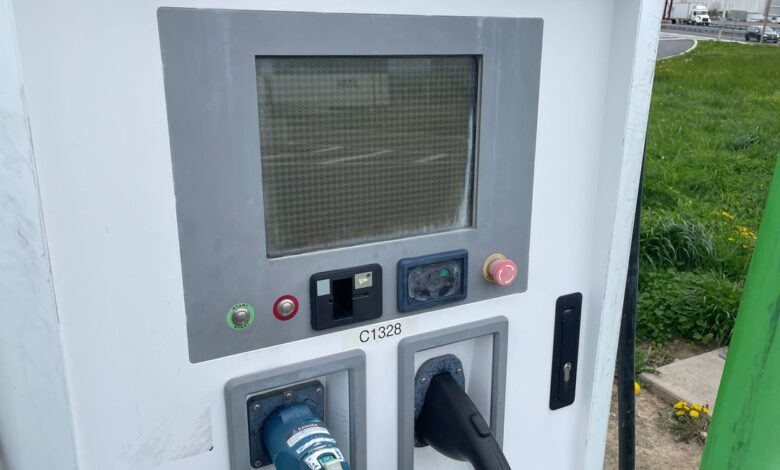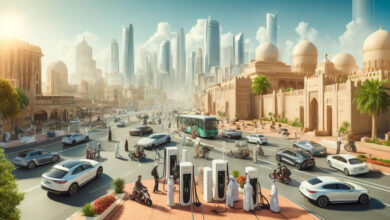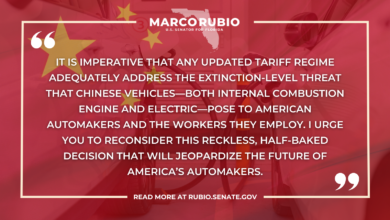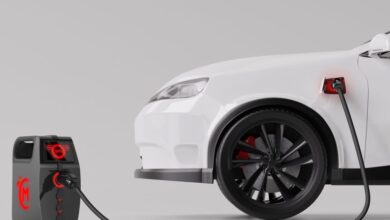NJ electric vehicle drivers say more chargers needed to get over ‘range anxiety’

Gov. Phil Murphy’s administration says New Jerseyans should expect to soon see plans for expanding New Jersey’s electric vehicle charging network as the state ramps up efforts to get more EVs on the road.
New Jersey has already far surpassed its goal to have 1,400 publicly accessible chargers installed by the end of 2025. But EV advocates, auto industry experts and drivers alike say the state must still do far more to build out charging infrastructure if buyers are going to get over their “range anxiety” — a driver’s worry that they won’t be able to find chargers to help them make it through a long trip.
Over the last few years, New Jersey has increased its charger availability through financial incentives to communities and businesses, and state investments that particularly emphasized major thoroughfares — like a $25 million project to install 200 chargers along the New Jersey Turnpike and Garden State Parkway this year. And state officials say the emphasis on highly trafficked areas will continue. But some industry experts say chargers will need to ultimately be about as ubiquitous as gas stations, with many more thousands of charging ports throughout the state.
“These days you have to plan [around charger availability],” said Ken Hunnold, a Chevrolet Bolt owner from Hackettstown, while attending a recent EV meetup organized by the New Jersey Electric Vehicle Association in Bridgewater. “Right now the worst thing about the conversion to electric vehicles is the charging infrastructure.”
Drivers who’ve already purchased plug-in cars say they frequently struggle to find available ports. In New Jersey, there are 30 registered electric vehicles or plug-in hybrids for every one charging port, according to a Gothamist analysis of 2022 charger and registered vehicle counts from the U.S. Department of Energy’s Alternative Fuels Data Center, using the most recent records available. That’s fewer ports per existing plug-in vehicle than any state or the District of Columbia.
Part of the reason for the disparity is the state’s high level of EV and plug-in hybrid adoption relative to many other states. According to the data, New Jersey has the sixth most registered plug-in vehicles in the country, though it’s the 11th most populous state. Registrations grew nearly 60% as well last year, after the period accounted for in the federal data.
New Jersey has ambitious goals for plug-in vehicle adoption. It seeks to double the amount of registered zero-emissions vehicles to 330,000 by the end of next year, despite skepticism from some retailers. Under a state Department of Environmental Protection rule adopted last year, zero-emission vehicles must account for more than half of new car sales by 2027, and must make up all new car sales by 2035.
The “zero emissions” category includes both all-electric and plug-in hybrid vehicles, as well as the much less common hydrogen fuel cell electric vehicles.
Preethy Thangaraj, deputy director of the Governor’s Office of Climate Action and the Green Economy, said that while the state has several ongoing initiatives to build out charging infrastructure, setting new goals for charger deployment is “top of mind.”
“We know how much these policy goal posts drive near- and long-term action for the state,” she said.
The law that passed in 2020 called for having 1,000 “level 2” chargers — the kind that can fully charge an EV’s battery overnight — in place before the end of 2025. New Jersey has paced ahead of that goal: There are already 2,328 publicly accessible level 2 ports around the state, according to the Murphy administration.
The law also called for having in place 400 direct-current fast chargers — which can fill an EV battery in about a half hour — in place before the end of 2025. Again, New Jersey is ahead: There are 1,063 fast charger ports in place, including the proprietary Tesla “Supercharger” ports, which require adapters for use with some cars but which are being opened up to more vehicles over the next year. Advocates say fast chargers are critical to assuring drivers that they can take their cars on long trips.
But when Hunnold, the Chevrolet Bolt owner, takes his car on a long trip, like his drive to upstate New York to see the recent solar eclipse, he’s still cautious to make sure there is a charging station that he can stop at every few hours. He plans to be at each for at least 20 minutes.
“The problem is that a lot of the chargers don’t work,” Hunnold said.
Linda Rockmaker, a Somerset resident and Honda Clarity plug-in hybrid driver who also attended the Bridgewater meetup, said she only spent $287 on gas all of last year. But Rockmaker said she gets “ICE’d” all the time.
“ICE means internal combustion engine. So when people park in spots that are meant to be charging spots only and they have conventional vehicles, then you get ICE’d,” she said.
Hannah Greenberg, a Tesla owner from Jersey City who was at the meetup, said her family has had some “panic moments” with charging.
“You have like 5% left and you’re kind of circling to find where there could actually be an EV charger,” she said.
Greenberg added her car has a built-in navigation system that directs her to available chargers, but “sometimes they’re really well-hidden.”
Existing plug-in owners aren’t the only ones who are anxious about the state of charging. Clarissa Fahey, from Bound Brook, stopped by the EV event to explore future vehicles for her family. But she said charging anxiety mostly keeps her from getting onboard with EVs.
“My biggest reservation is that the infrastructure is not sound yet,” she said.
Thangaraj, from the governor’s office, declined to say what targets the Murphy administration has in mind for its statewide charger goals beyond 2025. But she said the public should hear the plans “shortly.”
She said discussions about building out the state’s charging infrastructure will take place next month, when agencies convene to start crafting New Jersey’s next energy master plan — last updated in 2019 — which will serve as a guidance document for state administrators and policymakers for all things clean energy.
Pam Frank, CEO of ChargEVC, a nonprofit coalition that promotes growth of the EV market in New Jersey, worked on a study starting in 2016 that helped inform the charger goals that went into the 2020 legislation. She said ChargEVC is also aiming to release its own analysis, possibly as soon as this week, on what the state needs to provide in public charging.
Frank said officials will need to consider how much charging is done using level 2 chargers that many plug-in owners have installed in their own garages, in 240-volt outlets, like the kind usually used for electric dryers. Some plug-in owners additionally use the much slower level 1 chargers that plug into typical 120-volt wall outlets, but those only get a driver a few miles of range per hour of charging.
“We’ve got about 6 million light duty cars on the road [in New Jersey]. Ultimately, we need to consider that not all of them are going to fuel using fast chargers. In fact, the majority of them are going to fuel using overnight at home chargers,” she said.
Jim Appleton, president of the New Jersey Coalition of Automotive Retailers, agreed it’s “tough to say” how many chargers the state ultimately needs. But he said if New Jersey would do well to have as many charging areas as it does gas stations — about 2,400 — each with a few ports.
Thangaraj pointed to initiatives that the state is already undertaking, or plans to soon, to build up charging infrastructure.
New Jersey will soon tap into the $104 million that the Biden administration has earmarked for the state through the National Electrical Vehicle Infrastructure program, she said.
The program, signed into law in 2021, allocates $7.5 billion to states to build tens of thousands of chargers across the United States. But Politico reports that as of late last year, no chargers had yet been built with the funding as state governments and the charging industry slowly navigated contracting and performance requirements and dealt with the prospect of congressional Republicans cutting off funding. Ohio, New York and Pennsylvania opened their first NEVI-funded charging stations this year, and Thangaraj said New Jersey will follow suit after completing legal reviews.
Thangaraj noted that the state has “pots of money coming from a little bit of everywhere” to support public charging. She highlighted clean energy funds in the state budget as well as nearly $10 million from the general fund being spent on charging infrastructure.
The state Department of Energy also offers businesses and towns incentives such as its “It Pay$ to Plug In program,” which provides funding to build charging stations. And it offers residents cash incentives for installing level 2 chargers at home.
As part of the 2019 plan, the state Department of Environmental Protection developed strategies for the placement of chargers around the state. According to DEP, the initial phase focused on installing fast chargers on “major travel corridors” in New Jersey like interstate highways. Officials expect that emphasis to continue.
“The biggest priority for New Jersey when it comes to building out the charging network is that we prioritize buildout in highly trafficked areas to address a lot of the range anxiety,” Thangaraj said.



